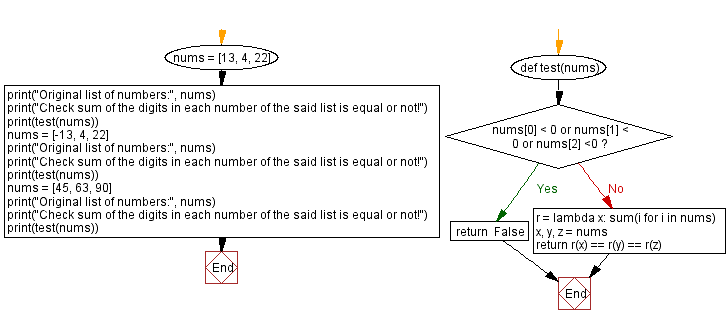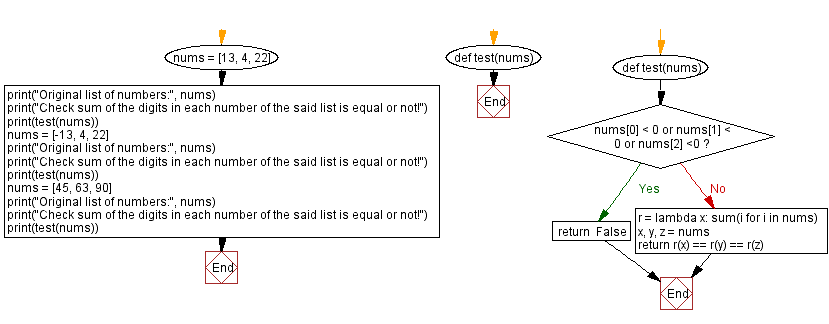Python Exercises: Sum of the digits in each number in a list is equal
Sum of Digits Equality
A Python list contains three positive integers. Write a Python program to check whether the sum of the digits in each number is equal or not. Return true otherwise false.
Sample Data:
([13, 4, 22]) -> True
([-13, 4, 22]) -> False
([45, 63, 90]) -> True
Sample Solution-1:
Python Code:
# Function to check if the sum of digits in each number of the list is equal.
def test(nums):
# Check if the sum of digits in each number of the list is equal.
return nums[0] % 9 == nums[1] % 9 == nums[2] % 9
# Example usage of the function with different lists of numbers.
nums = [13, 4, 22]
print("Original list of numbers:", nums)
print("Check sum of the digits in each number of the said list is equal or not!")
print(test(nums))
nums = [-13, 4, 22]
print("\nOriginal list of numbers:", nums)
print("Check sum of the digits in each number of the said list is equal or not!")
print(test(nums))
nums = [45, 63, 90]
print("\nOriginal list of numbers:", nums)
print("Check sum of the digits in each number of the said list is equal or not!")
print(test(nums))
Sample Output:
Original list of numbers: [13, 4, 22] Check sum of the digits in each number of the said list is equal or not! True Original list of numbers: [-13, 4, 22] Check sum of the digits in each number of the said list is equal or not! False Original list of numbers: [45, 63, 90] Check sum of the digits in each number of the said list is equal or not! True
Explanation:
Here is a breakdown of the above Python code:
- Function definition:
- def test(nums):: Defines a function named "test()" that takes a list of three numbers (nums) as input.
- Conditional check:
- return nums[0] % 9 nums[1] % 9 nums[2] % 9: Checks if the sum of the digits in each number of the list is equal.
Flowchart:

Sample Solution-2:
Python Code:
# Function to check if the sum of digits in each number of the list is equal.
def test(nums):
# Check if any number in the list is negative.
if nums[0] < 0 or nums[1] < 0 or nums[2] < 0:
return False
# Lambda function to calculate the sum of digits in a number.
r = lambda x: sum(int(i) for i in str(x))
# Unpack the list into three variables x, y, and z.
x, y, z = nums
# Check if the sum of digits is equal for all numbers in the list.
return r(x) == r(y) == r(z)
# Example usage of the function with different lists of numbers.
nums = [13, 4, 22]
print("Original list of numbers:", nums)
print("Check sum of the digits in each number of the said list is equal or not!")
print(test(nums))
nums = [-13, 4, 22]
print("\nOriginal list of numbers:", nums)
print("Check sum of the digits in each number of the said list is equal or not!")
print(test(nums))
nums = [45, 63, 90]
print("\nOriginal list of numbers:", nums)
print("Check sum of the digits in each number of the said list is equal or not!")
print(test(nums))
Sample Output:
Original list of numbers: [13, 4, 22] Check sum of the digits in each number of the said list is equal or not! True Original list of numbers: [-13, 4, 22] Check sum of the digits in each number of the said list is equal or not! False Original list of numbers: [45, 63, 90] Check sum of the digits in each number of the said list is equal or not! True
Explanation:
Here is a breakdown of the above Python code:
- Function definition:
- def test(nums):: Defines a function named test that takes a list of three numbers (nums) as input.
- Conditional check:
- if nums[0] < 0 or nums[1] < 0 or nums[2] < 0:: Checks if any number in the list is negative.
- return False: Returns False if any number is negative.
- Lambda Function:
- r = lambda x: sum(int(i) for i in str(x)): Defines a lambda function (r) to calculate the sum of digits in a number.
- Unpacking and Comparison:
- x, y, z = nums: Unpacks the list into three variables (x, y, and z).
- return r(x) r(y) r(z): Checks if the sum of digits is equal for all numbers in the list.
Flowchart:

For more Practice: Solve these Related Problems:
- Write a Python program to check if the sum of digits of each number in a three-element list are all equal.
- Write a Python program to compute the digit sum for each number in a list and verify that all sums are identical.
- Write a Python program to compare the sum of digits of three numbers and return True if they are all equal.
- Write a Python program to iterate over a list of three numbers, sum their digits, and check if the sums match.
Go to:
Previous: Check square root and cube root of a number
Next: Check the numbers that are higher than the previous.
Python Code Editor:
Have another way to solve this solution? Contribute your code (and comments) through Disqus.
What is the difficulty level of this exercise?
Test your Programming skills with w3resource's quiz.
